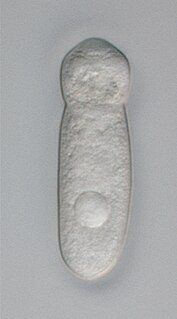Related Research Articles

Plasmodium is a genus of unicellular eukaryotes that are obligate parasites of vertebrates and insects. The life cycles of Plasmodium species involve development in a blood-feeding insect host which then injects parasites into a vertebrate host during a blood meal. Parasites grow within a vertebrate body tissue before entering the bloodstream to infect red blood cells. The ensuing destruction of host red blood cells can result in disease, called malaria. During this infection, some parasites are picked up by a blood-feeding insect, continuing the life cycle.

The South American foxes (Lycalopex), commonly called raposa in Portuguese, or zorro in Spanish, are a genus from South America of the subfamily Caninae. Despite their name, they are not true foxes, but are a unique canid genus related to wolves and jackals; some of them somewhat resemble foxes due to convergent evolution. The South American gray fox, Lycalopex griseus, is the most common species, and is known for its large ears and a highly marketable, russet-fringed pelt.

Caniformia is a suborder within the order Carnivora consisting of "dog-like" carnivorans. They include dogs, bears, wolves, foxes, raccoons, badgers, seals and mustelids. The Pinnipedia are also assigned to this group. The center of diversification for Caniformia is North America and northern Eurasia. Caniformia stands in contrast to the other suborder of Carnivora, Feliformia, the center of diversification of which was in Africa and southern Asia.

The gregarines are a group of Apicomplexan alveolates, classified as the Gregarinasina or Gregarinia. The large parasites inhabit the intestines of many invertebrates. They are not found in any vertebrates. However, gregarines are closely related to both Toxoplasma and Plasmodium, which cause toxoplasmosis and malaria, respectively. Both protists use protein complexes similar to those that are formed by the gregarines for gliding motility and invading target cells. This makes them excellent models for studying gliding motility with the goal of developing treatment options for toxoplasmosis and malaria. Thousands of different species of gregarines are expected to be found in insects, and 99% of these gregarines still need to be described. Each insect can be the host of multiple species. One of the most studied gregarines is Gregarina garnhami. In general, gregarines are regarded as very successful parasites, as their hosts are spread over the entire planet.
In phylogenetics, basal is the direction of the base of a rooted phylogenetic tree or cladogram. The term may be more strictly applied only to nodes adjacent to the root, or more loosely applied to nodes regarded as being close to the root. Each node in the tree corresponds to a clade; i.e., clade C may be described as basal within a larger clade D if its root is directly linked to the root of D. The terms deep-branching or early-branching are similar in meaning.

The Eucoccidiorida are an order of microscopic, spore-forming, single-celled parasites belonging to the apicomplexan class Conoidasida. Protozoans of this order include parasites of humans, and both domesticated and wild animals including birds. Among these parasites are the Toxoplasma gondii that cause toxoplasmosis and Isospora belli, which results in isosporiasis.

The Caninae, known as canines, are one of three subfamilies found within the canid family. The other two canid subfamilies are the extinct Borophaginae and Hesperocyoninae. The Caninae includes all living canids and their most recent fossil relatives. Their fossils were first found in North America and dated to the Oligocene era, then spreading to Asia at the end of the Miocene era, some 7 million to 8 million years ago.

Adeleorina is a suborder of parasites in the phylum Apicomplexa.
Eimeriorina is a suborder of phylum Apicomplexa.
Aggregata is a genus of parasitic alveolates belonging to the phylum Apicomplexa.
Frenkelia is a genus of parasites in the phylum Apicomplexa. The species in this genus infect the gastrointestinal tracts of birds of prey and the tissues of small rodents.
Hammondia is a genus of parasitic alveolates in the phylum Apicomplexa.
The Archigregarinorida are an order of parasitic alveolates in the phylum Apicomplexa. Species in this order infect marine invertebrates — usually annelids, ascidians, hemichordates and sipunculids.
Hyaloklossia is a genus of parasitic alveolates in the phylum Apicomplexa. Only one species in this genus is currently recognised - Hyaloklossia lieberkuehni.
The Neogregarinorida are an order of parasitic alveolates in the phylum Apicomplexa. Species in this order infect insects and are usually found in the fat body, hemolymph, hypodermis, intestine or Malpighian tubules. The most common site of infection is the fat body: many species are pathogenic for their hosts.
Meroselenidium is a genus of parasitic alveolates in the phylum Apicomplexa. Species in this genus infect marine invertebrates.
Siedleckia are a genus of parasitic alveolates in the phylum Apicomplexa. Species in this genus infect marine invertebrates.
Hammondia hammondi is a species of obligate heteroxenous parasitic alveolates of domestic cats. Intracellular cysts develop mainly in striated muscle. After the ingestion of cysts by cats, a multiplicative cycle precedes the development of gametocytes in the epithelium of the small intestine. Oocyst shedding persists for 10 to 28 days followed by immunity. Cysts in skeletal muscle measure between 100 and 340 μm in length and 40 and 95 μm in width. Some of the intermediate hosts develop low levels of antibody and some cross-immunity against Toxoplasma.
Blabericolidae is a family of parasitic alveolates in the phylum Apicomplexia.
References
- 1 2 Ogedengbe; et al. (2016). "Molecular phylogenetic analyses of tissue coccidia (sarcocystidae; apicomplexa) based on nuclear 18s RDNA and mitochondrial COI sequences confirms the paraphyly of the genus Hammondia". Parasitology Open. 2: e2. doi: 10.1017/pao.2015.7 .
| This Apicomplexa-related article is a stub. You can help Wikipedia by expanding it. |